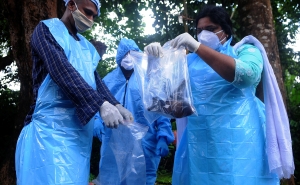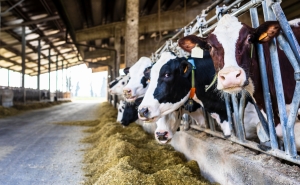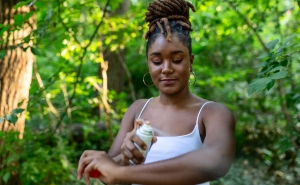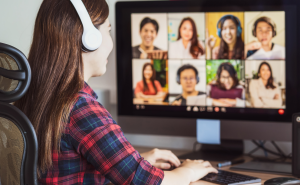Monkeypox Outbreak Expert Panel: Testing, Containment, Vaccines, and More
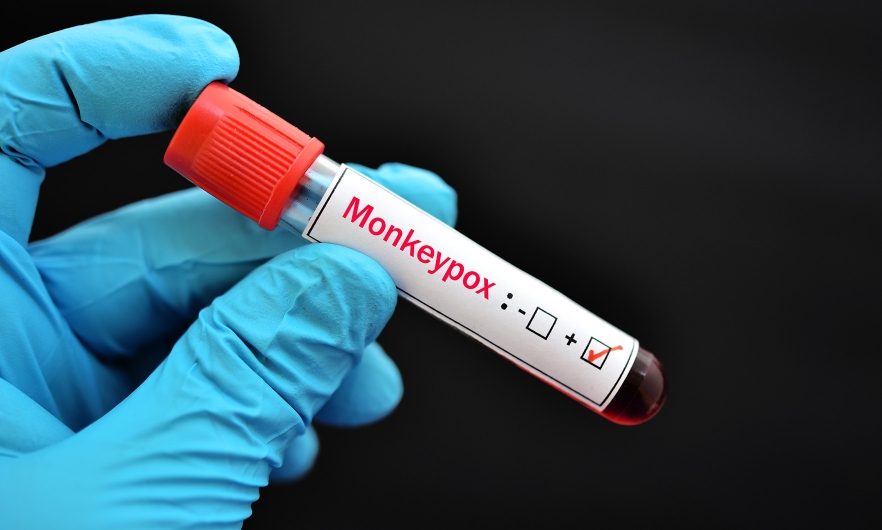
Since June, there have been over 10,000 confirmed monkeypox cases in the U.S. In early August, the Biden administration declared monkeypox a public health emergency with several states such as California and Illinois, and cities like New York and San Francisco following suit.
On August 10, a panel of Johns Hopkins experts including Amesh Adalja, MD, Noreen Hynes, MD, and William Moss, MD, PhD from the School of Public Health, and Jason Farley from the School of Nursing, gathered to discuss the monkeypox emergency. Lainie Rutkow moderated the conversation.
The panel covered topics such as the prevention, testing, and treatment of monkeypox; ways of reducing stigma around the outbreaks; and the limited availability and distribution of monkeypox vaccines. The following is an overview of the conversation with key takeaways.
Watch the full recording of the event here, and read The Hub’s recap here.
PREVENTION, TESTING, AND TREATMENT
What does monkeypox testing look like right now in terms of availability?
AA: Testing has gotten better in the last several weeks than it was early on, where it was really restricted to CDC-affiliated laboratories, which is not adequate in an infectious disease emergency. We have to think about making testing much more distributed, even more so than it is right now. This should be something at clinics, where individuals presenting for care can be tested quickly.
We are limited because this is a test that requires you to swab skin specimens, and lesions may not be the first symptoms individuals get. We need to think about whether we can do saliva testing, or can we do other ways of testing so that people can know their status earlier.
There are some technological hurdles there. Just as it was with COVID-19, testing has become a major barrier to getting a handle on the outbreak.
How are antivirals like Tecovirimat or Tpoxx helpful?
NH: Even if someone has monkeypox, they don't necessarily need to receive an antiviral because the particular strain that's circulating in the U.S., and worldwide outside of the endemic area, is something that is usually mild and has a very low case fatality rate.
Until we have enough antivirals, we’re probably not going to administer [them] to someone who can stay quarantined. But we might be more likely to use one of the three antivirals that we have on someone who needs to be in a congregate living space.
How concerned should people be about potential exposure of monkeypox during domestic or international travel?
JF: What we know right now is that your personal risk of coming in contact with an individual who might have monkeypox is still relatively low. We have limited data on how long monkeypox lives on surfaces, and whether or not it’s replicating or a transmissible virus is still an area of debate. I would say you should feel free to travel.
I do have patients using pre-exposure prophylaxis for HIV that are planning travel to endemic areas where currently there are a lot of cases among men who have sex with men, and I caution them about harm reduction strategies while they are traveling.
CONTAINING SPREAD
How do we know that monkeypox can be controlled?
AA: Contagiousness during the incubation period is a key factor. That's why SARS-CoV-2 is so hard to control and why the 2009 H1N1 pandemic spread throughout the world in a matter of months.
If something is contagious during its incubation period, it's very hard to intervene. We don't seem to see that with monkeypox—just like we didn't see that with smallpox—and that's actually one of the key reasons why smallpox could be eradicated.
What do we know about the sexual spread?
AA: Around 2017 in Nigeria, there was person-to-person spread in individuals who had multiple sex partners and a lot of the lesions were in the genital area. There’s an understanding that this virus could get into sexual networks and spread through that close contact.
It's important to use the words “sexual network” or “close contact” because it's not clear at this point if monkeypox is behaving as a strictly sexually transmitted infection, meaning the virus being is conveyed from one person to another through bodily fluids.
What’s the fastest route to containment at this point?
AA: When we think about how smallpox was eradicated, they didn’t vaccinate everybody. They just vaccinated close contacts of [infected] individuals using contact tracing.
This did not work for monkeypox because many people did not know who they were in contact with and who might have been exposed. The containment [strategy] here will be getting the vaccine to at-risk individuals, [such as] a man who has sex with multiple partners, or goes to those types of events where [monkeypox has been] spread.
We [also] have to think about harm reduction. Having a new sexual partner right now is a risk factor for monkeypox. Think about decreasing the number of partners you have until you're vaccinated or immune, or exchanging information with people so that contact tracing is possible.
What does isolation look like for suspected or confirmed monkeypox patients?
JF: Individuals should isolate at home until the lesions have completely healed, without contact with other individuals. Try to avoid sharing as much common area as possible. Individuals should also be wiping down surfaces in shared spaces, and avoid sharing bathroom facilities. Do not share anything that would have contact with the skin, including soap.
Obviously, individuals who are experiencing homelessness and others have a different set of recommendations within congregate settings.
Can someone who has had monkeypox be reinfected?
JF: We don't have a lot of data on this, but we can extrapolate what we know about other orthopox infections, namely smallpox.
Individuals who were infected with smallpox were protected from reinfection. There’s likely a similar phenomenon that occurs with monkeypox, where people are not going to get reinfected—and definitely not immediately.
There may be some time over several years that somebody could get reinfected, or that their immunity wanes, or if they [become] immunosuppressed. In general, we expect most people to not be susceptible to reinfection in the near term, which I think will be useful when it comes to thinking about the trajectory of this outbreak in non-endemic countries.
REDUCING STIGMA
How has stigma played a role in this outbreak?
JF: The vast majority of cases in the monkeypox outbreak have been among men who have sex with men, but we know that transmission is certainly not limited to that group. Many public health experts are concerned about the dangers of stigma and discrimination in relation to the outbreak.
The impact of the diagnosis of monkeypox and living with this infection can have a very overwhelming effect on the individuals being diagnosed and experiencing considerable symptoms.
With this particular illness, stigma has presented itself in a variety of different ways:
- The outward physical manifestations of the illness lead to the potential for underdiagnosis or unintentional disclosure by strangers. An individual can look at another person, see that they have monkeypox, and exhibit symptoms of outright stigma directed at the individual who is experiencing it.
- Labeling the outbreak as a disease among gay, bisexual and other men who have sex with men, is certainly both necessary from a harm reduction perspective, but also a stigmatizing message at the same time. Historically, this has not been a disease associated with the gay community. [Monkeypox] has taken the opportunity and the vulnerability of social networks to establish itself in the current outbreak—different from the prior outbreaks of this infection.
- Limited access to diagnosis, prevention, and treatment has resulted in those currently most at risk feeling forgotten, undervalued, and mistreated.
For example, a patient in his mid-thirties is a gay man, [and] he is not “out” to his employer or many of his family members. A diagnosis of monkeypox means notifying friends, family, and sexual partners within his network. Contact investigations include his place of employment.
His fear really intensified when we began to discuss the recommendations around how long to remain in isolation and telling his employer about his monkeypox, potentially leading to his outing as a gay man. He feared losing his employment when he was told he needed to isolate until all lesions had crusted and healed, and new skin had formed. For an individual not taking [antiviral] therapy, this could be three to four weeks, and for someone with therapy about two weeks.
There have been comparisons of monkeypox stigma to stigma faced by this community of people during the early days of the HIV/AIDS epidemic. What are some parallels?
JF: Too many people currently at risk of monkeypox infection continue to face limited access to prevention treatment, and sex-positive harm reduction strategies. This fuels the dehumanization of a community who are fundamentally pro-science, pro-harm reduction, pro-vaccine, and are pleading for access to prevention and care services.
This harkens back 40 years to the beginning of the AIDS epidemic when the media and the world jumped on the gay community and the intersex community as pariahs of people causing AIDS.
Now, we know that HIV was circulating among heterosexual individuals for decades before we identified it in the gay population. Historically, monkeypox outbreaks are not centered within the gay community.
VACCINES
What vaccines do we have?
WM: There are two vaccines, the MVA-Bavarian Nordic, which is a live but nonreplicating vaccine, also called by its brand name JYNNEOS, and a live replicating smallpox vaccine called ACAM2000.
MVA-BN was originally created by the Department of Health and Human Services as an alternative vaccine against smallpox in the event of a smallpox bioterrorism event to be given to individuals who should not receive the live replicating vaccine, particularly people who are immunocompromised, or the many people who have things like eczema, which can be problematic.
There are not enough of the non-replicating JYNNEOS vaccine. On August 9, the FDA announced that they were going to permit fractional dosing, getting five doses out of one usual dose. There will still be two doses that people get [in the series].
The ACAM2000 is a much more reactogenic vaccine with a lot more side effects.
Why is the availability of these vaccines such an issue?
WM: The U.S. government is currently distributing about 1.1 million doses, but some experts estimate that we need at least 3.5 million doses, and that need may expand as transmission increases.
There have been missteps along the way. At one point, the U.S. government had about 20 million doses of the JYNNEOS vaccines stored in the national stockpile, but those expired.
There were delays in getting the 1.1 million doses that are currently being allocated by the U.S. government, delays in requesting these from the manufacturer Bavarian Nordic in Denmark, and then also delays in additional orders of the 5.5 million.
The U.S. government has invested more than $1 billion in this vaccine and reportedly owns about 16.5 million doses, but those doses were stored in bulk, not in the vaccine vials that we need in order to distribute these to the points of administration.
How can availability be fixed?
WM: The U.S. government is looking to contract another firm that can actually do what's called the “fill and finish”—taking the bulk vaccine and bottling, capping, and labeling it. That will expedite the availability of additional vaccines.
In some jurisdictions, there have been proposals or actual implementation of a delayed second dose. There is some concern about this because although we don't have great data, it's that second dose that really boosts the neutralizing antibody levels.
The biggest news lately has been fractionated intradermal dosing. On August 8, the FDA issued an emergency use authorization for the use of intradermal injection, which is one-fifth of those of the standard subcutaneous dose for people 18 years or older. There is a biological rationale for a lower dose of a vaccine administered intradermally because of the high abundance of immune reactive cells or antigen-presenting cells in the dermis. There are also long historical examples of using fractionated intradermal dosing for yellow fever, inactivated polio vaccine, rabies vaccine, and meningococcal vaccine. We have a fair amount of experience with this.
What does the distribution of monkeypox vaccines look like?
Using a similar framework for COVID-19 vaccines, there are four D’s essential to a successful and effective vaccine rollout: doses, delivery, demand, and data.
Once doses are available, we need mechanisms—delivery—to get them into eligible populations. Given the vaccine supply shortage, the JYNNEOS vaccine is recommended for post-exposure prophylaxis, or what's called expanded post-exposure prophylaxis for individuals with known or presumed exposure to someone with monkeypox or with behaviors or experiences that put them at risk.
Currently, it's not widely recommended that these vaccines be used or the JYNNEOS vaccine be used as what's called pre-exposure prophylaxis, although the CDC guidelines say that this can be considered, as vaccine supply shortages are remedied.
We have a very high demand right now, but we do need to ensure that going forward—particularly among those most vulnerable groups and groups with suspicions of either vaccines or the government—that demand remains high as vaccine supplies improve.
[In terms of] data, we need to be able to know how many individuals have been vaccinated with one or two doses. This is our opportunity to learn about the effectiveness of these vaccines against monkeypox. We have very limited data, both with the subcutaneous administration and particularly with the intradermal administration.
The goal of our vaccination program is quite different from the one for COVID 19, where the primary goal was preventing severe disease, hospitalization, and death. We're not seeing that with the current monkeypox outbreak. We just want to prevent infection.
If someone received a smallpox vaccination, what does that mean relative to monkeypox?
WM: Despite the fact that we're using vaccines designed for smallpox, there's not actually a whole lot of evidence around the protective efficacy of smallpox vaccines against monkeypox, although we know that there's a lot of cross-immunity with the different orthopoxviruses. One of the studies is from the early 1980s in the DRC, where they showed that individuals who had been previously vaccinated against smallpox had protection against monkeypox.
That said, smallpox vaccination ceased 50 years ago here in the U.S., and the duration of protection following smallpox vaccination is not lifelong. It's a function of how many doses an individual received and whether they had any boosting due to exposure to natural smallpox.
My sense would be that there's probably little to no protection conferred by prior smallpox vaccination 50 years ago or longer. There may be some protection against more severe disease. But again, we're not really seeing a lot of severe disease with this current monkeypox outbreak.
Amesh Adalja, MD, is a senior scholar at the Center for Health Security and an adjunct professor in Environmental Health and Engineering at the Johns Hopkins Bloomberg School of Public Health. He is also an affiliate of the Johns Hopkins Center for Global Health.
Noreen Hynes, MD, is an associate professor in International Health; Population, Family and Reproductive Health; and Environmental Health and Engineering. She has a primary appointment with the Johns Hopkins School of Medicine.
William J. Moss, MD, MPH, is the executive director of the International Vaccine Access Center, deputy director of the Malaria Research Institute, and a professor in the departments of Epidemiology, International Health, and Molecular Microbiology and Immunology at the Johns Hopkins Bloomberg School of Public Health.

